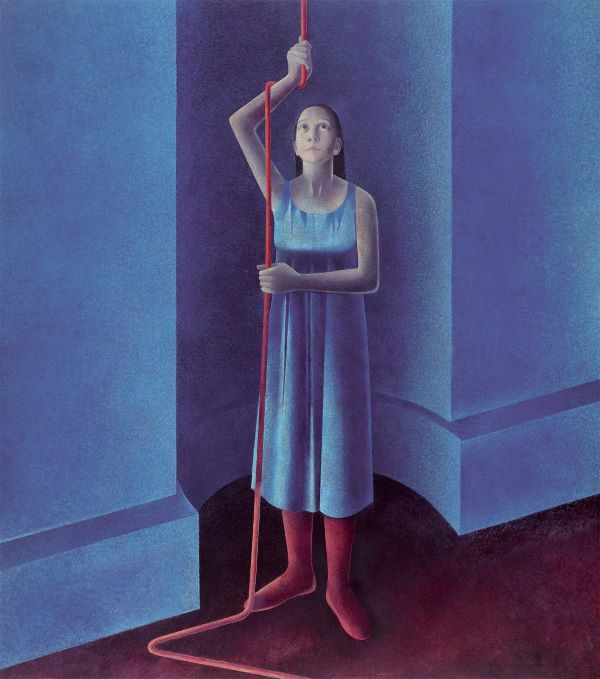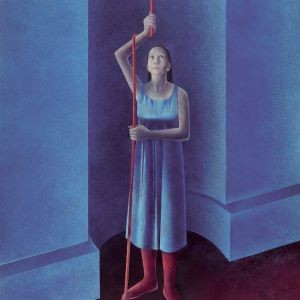Jiří Šťourač
Prague Castle - Queen Anne's Summer Palace, Mariánské hradby 52/1, Praha 1
June 29, 2023 - October 31, 2023
 |
Jiří ŠťouračPrague Castle - Queen Anne's Summer Palace, Mariánské hradby 52/1, Praha 1June 29, 2023 - October 31, 2023
The paintings by Jiří Štourač enrich both of the palace ground-floor halls. While motifs of the Mediterranean architecture, interiors, and still lifes dominate the first one, visitors will encounter large-format canvases with figural paintings in the second, bigger hall. Štourač often portrays his relatives, yet he transfers the concrete moment of an encounter to an idealised space, constructing the figures’ final stances or gestures on canvas always anew and level-headedly. The human body is related to geometry. Jiří Štourač dwells with the same motif for a long time – a painting displayed in the Belvedere may reappear in a modified way at a future exhibition of the artist. In any case, the painter’s almost unlimited time becomes reflected in his works. Instead of watching a fleeting moment captured by the artist, the spectator observes dreamlike, archetypal scenes, whose timelessness penetrate even deeper into memory. A human by Štourač is deep in thought, concentratedly engrossed under the disturbed surface of everyday life. The movement is reduced to a minimum, even fully excluded in the majority of paintings. When Štourač’s figures – typically mostly women – look into the distance, they see through the slit of the horizon deep inside things and phenomena, into the light and darkness of perpetual human questions. As a contrast and a small disruption of the calm assemblage, the last part of the exhibition brings into focus a series of black and white illustrations for The Plague, a famous book by Albert Camus. Although Jiří Štourač drew them before the Covid-19 pandemic broke out, one cannot help this association. The summer palace’s structure provides one more parallel – when a deadly disease broke out in Italian towns in the past, the countryside Renaissance villas and palaces provided safe hideaways for long months. That third level of resonance is represented by the act that, according to some researchers, Albert Camus wrote his philosophical novel as an admonitory allegory of the infection by fascism. A serene world of things, a painting as a transcending membrane for the big questions of humanity, but also an invasion of ungraspable danger, perhaps even as a concrete symbol, a mirror of our latest uneasy situations, is the space where Jiří Štourač invites his audience. The Royal Summer Palace itself is food for deeper thought. In addition to the exhibition, visitors can climb up to the second floor of the extraordinary Renaissance structure and, after many years, even set foot on the adjacent spacious terrace. Commissioned by Holy Roman Emperor Ferdinand I and built by the Italian master Paolo della Stella around the mid-16th century, the structure includes two more unique painting series that are worthy of scrutiny. The first one is the series of the Renaissance reliefs featuring the scenes from the Greek and Roman myths. It is one of the most extensive classical mythology painting encyclopaedias north of the Alps. In places, the series is updated with the allegories glorifying the Habsburg builder and his dynasty. The second series will be described below. The Belvedere is a dazzling structure that makes you lift your head in astonishment. Its architecture connects to its surroundings to a maximum. It arouses joy and offers fascinating views of neighbouring gardens, parks, and all of Prague. The Belvedere’s terraces provide distant views alongside the Vltava to mythical Závist – a site of the first cultural transfer from Ancient Greece to the Czech lands – nearly all the way to somewhere in Arcadia. Slightly aloof, making a counterpoint to the summer palace – almost within reach if there were not the wild Stag Moat – is located Prague Castle. It stretches on an east-west promontory as a mighty ancient druse, accumulated over the ages, the most precious and most extensive petrified book of our history. The layers open up beautifully when viewed from the summer palace. By contrast, the Belvedere is a gesamtkunstwerk at first sight, a refined jewel built on the south-north axis, a confined chapter of a short epoch. Yet, the Belvedere is no romantic dream about Italy, it actually is Italy. It complements the fortified castle in a manner of a modern monarch. The royal lusthaus was not only designed for innocent merriments and feasts. It is an imperial structure, whose architecture and iconography attests to the newly acquired hereditary claims of the Habsburgs to the Bohemian throne. The open lightweight structure conceals a hard core. Similar to the incomplete Prague Castle – since history has not ended yet –, at last the Belvedere has not been spared visible changes. It also holds a dream about the Czech National Revival, the traces of its contradictory layers, and even the failure of some. The summer palace’s interior has been rebuilt radically, the new monumental staircase designed as an entrance to a Czech version of Walhalla. In the large community hall on the second floor, the visitor encounters the second large painting series connected with the structure into perpetuity. The halls are almost completely covered with the series of academic murals by Christian Ruben and his pupils from the mid-19th century, depicting selected chapters from Czech history. The Renaissance edifice, references to antiquity, the dreams of the long 19th century, the town, the castle, the river, and the landscape – Prague’s Belvedere is a strong place imbued with history, doubts, and questions. Ascending to the large hall on the first floor, the visitor may ask the following questions: Why did the ancestors choose these very painting scenes and not others? How did the imperial censorship work back then? Why does the monogram FA recur on the façade? When was the palace exclusively attributed to Queen Anne with whom the summer palace is so closely associated today? How far can one see from the Belvedere? What can be seen from its terraces? And how does the current exhibition of Jiří Štourač expand and mirror all these layers? Hence, an abundant public programme enriches the opening of the exhibition and the Belvedere. Norbert Schmidt, Exhibition Curator The exhibition is organize by the Office of the President of the Czech Republic and the Prague Castle Administration.
|


